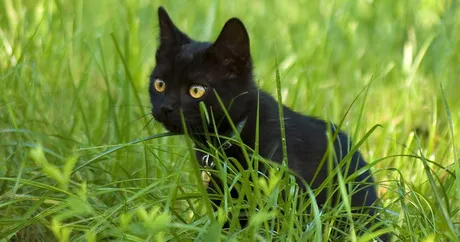When I first heard about Black Dog Syndrome, I thought it was an Internet hoax. A trainer who rescued a black Labrador Retriever told me that the shelter workers where she adopted her black Lab from were thrilled that she chose a black Lab over a yellow one.
If you are unaware, Black Dog Syndrome is when people don’t adopt dogs with black or dark fur. I grew up with a German Shepherd–Collie–Beagle mix who was mostly black and dark brown. He was extremely handsome, and quite intelligent, which made me think that Black Dog Syndrome just couldn’t exist.
Yet, I kept on hearing about it on chat rooms, on the Internet, from friends who do rescue work, and from people who work at animal shelters. One person told me that when she was looking to adopt a Labrador Retriever, she was astounded at the disparity between available yellow dogs versus black dogs. The wait for a yellow Lab from a rescue group could be months or years, while there were plenty of black Labs available.
Why black dogs are overlooked
Black dogs are often overlooked. When you place a bunch of black dogs in a shelter amongst tan, red, yellow, mixed and other colored fur, people’s gaze goes towards the lighter or brighter animals.
“As a brand marketing professional, I can tell you color is a powerful perception tool,” says Steven Vena, owner of The Nimble Group, Inc., a brand marketing and advertising agency. “If I am walking down the street, I would bet more people would pet the tan dog versus the black dog.”
I was able to see his point — even though I didn’t like it. I grew up in New York, and have a lot of black clothes in my closet. I remember attending an expo at the Javits Center; the majority of men dressed in black suits and the women wore black dresses. I came along in a bright orange blazer, and got lots of comments. Many people thanked me for wearing a sunny color.
Still when it comes to fur or skin color, I think black is more interesting because it’s not just black. Look at a cat, dog, or person with black coloring and you will see reds, browns, and a nice mix of other tones thrown in. Maybe because I’m extremely fair skinned, I appreciate other colors. I was thankful for my freckles; otherwise I would have a ghostlike complexion!
Photos of black dogs
Take a look at photos of adoptable dogs and cats online. Often shelter workers, not professional photographers, snap quick photos and post them. Unfortunately they are not very good, and all too often the black ones are blurry. Thankfully, many shelters are using professional photographers to show off these dogs and cats. Some shelters are adding color to these adoptable animals. You might see a black dog or cat with a colorful bandana or attractive colored collar. It makes the pet stand out.
Black cats

Black cats also have a hard time getting adopted. A lot of that has to do with superstitions. Personally, I had a black cat, and everyone loved him. He was the sweetest, and had a playful personality. His green eyes stood out against his expressive face.
I have trouble understanding this, but there are some people who regard black cats as witches’ familiars. It has gotten so bad that shelters won’t adopt out a black cat around Halloween time. It seems that people want to use black cats for rituals around that time. So a good number of shelters refuse to adopt out their black cats from the end of September to the beginning of November.
And I know this is going to sound screwy, but some people believe that vampires transform themselves into black dogs as a way of traveling unnoticed at night. (I just don’t get some people.) So unfortunately, black cats and dogs are the last, if at all, to be adopted.
Black Dog and Black Cat Syndrome are real. The next time you are looking to adopt a dog or cat, take personality into account. Talk to the shelter workers or the workers at the rescue group, and make an informed decision.
Michele C. Hollow writes Pet News and Views, a blog devoted to the positive side of animal welfare. Her blog covers news about people who work with and for animals and animal nonprofits.









